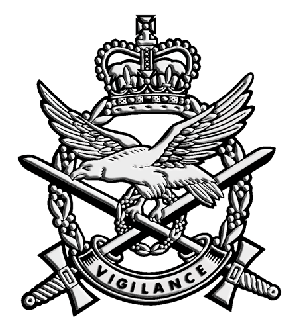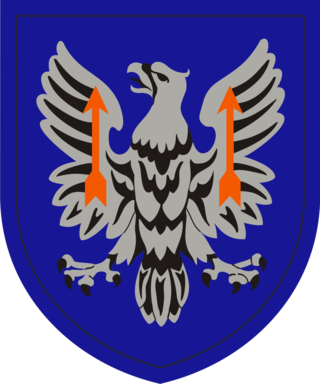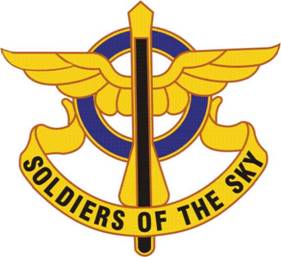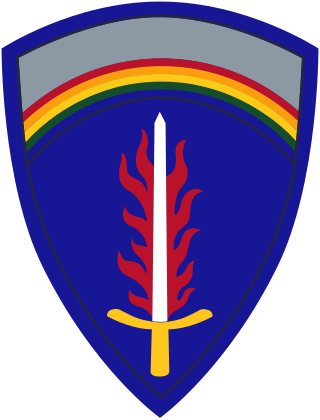
The 82nd Airborne Division is an airborne infantry division of the United States Army specializing in parachute assault operations into hostile areas with a U.S. Department of Defense mandate to be "on-call to fight any time, anywhere" at "the knife's edge of technology and readiness." Primarily based at Fort Liberty, North Carolina, the 82nd Airborne Division is part of the XVIII Airborne Corps. The 82nd Airborne Division is the U.S. Army's most strategically mobile division.

The 1st Cavalry Division is a combined arms division and is one of the most decorated combat divisions of the United States Army. It is based at Fort Cavazos, Texas. It was formed in 1921 and served during World War II, the Korean War, the Vietnam War, the Persian Gulf War, with the Stabilization Force in Bosnia-Herzegovina, in the Iraq War, in the War in Afghanistan as well as Operation Freedom's Sentinel and Operation Inherent Resolve. As of July 2023, the 1st Cavalry Division is subordinate to III Armored Corps and is commanded by Major General Kevin D. Admiral.
The Rapid Deployment Joint Task Force (RDJTF) is an inactive United States Department of Defense Joint Task Force. It was first envisioned as a three-division force in 1979 as the Rapid Deployment Force (RDF), a highly mobile rapid deployment force that could be rapidly moved to locations outside the normal overseas deployments in Europe and Korea. Its charter was expanded and greatly strengthened in 1980 as the RDJTF. It was inactivated in 1983, and re-organized as the United States Central Command (USCENTCOM).
In the United States Marine Corps, a Marine Air–Ground Task Force is the principal organization for all missions across the range of military operations. MAGTFs are a balanced air–ground, combined arms task organization of Marine Corps forces under a single commander that is structured to accomplish a specific mission. The MAGTF was formalized by the publishing of Marine Corps Order 3120.3 in December 1963, "The Marine Corps in the National Defense, MCDP 1-0". It stated:
A Marine air–ground task force with separate air ground headquarters is normally formed for combat operations and training exercises in which substantial combat forces of both Marine aviation and Marine ground units are included in the task organization of participating Marine forces.

The 1st Battalion, 227th Aviation Regiment is an attack helicopter battalion of the Combat Aviation Brigade, 1st Cavalry Division. The battalion is an AH-64 Apache battalion based at Fort Cavazos, Texas.
Task Force Mustang is the deployment unit name for the Combat Aviation Brigade (CAB), 36th Infantry Division, Texas Army National Guard. The CAB completed a tour of duty in support of Operation Iraqi Freedom in the fall of 2007 when it was relieved by the 12th Combat Aviation Brigade, a similarly constituted regular army unit. It deployed to Kuwait in April 2013 in support of Operation Enduring Freedom as part of Operation Spartan Shield, based at Camp Buehring.

The South Carolina Army National Guard is a component of the United States Army and the United States National Guard. Nationwide, the Army National Guard comprises approximately one half of the U.S. Army's available combat forces and approximately one third of its support organization. National coordination of various state National Guard units is maintained through the National Guard Bureau.
Task Force Falcon has been the name of several United States Army Task forces.

The Australian Army Aviation (AAAvn) is an administrative corps of the Australian Army. It was formed on 1 July 1968. The motto of the Australian Army Aviation corps is Vigilance.
The 229th Aviation Regiment is an aviation unit of the United States Army.

The 12th Combat Aviation Brigade is a Combat Aviation Brigade of the United States Army. It was first organized as the 12th Aviation Group at Fort Moore, Georgia, on 18 June 1965.
In 2009, the United States and NATO International Security Assistance Force (ISAF) coalition, along with Afghan National Army forces, continued military operations against the Taliban in Afghanistan. 2009 marks the eighth year of the War in Afghanistan, which began late in 2001. And 75th ranger regiment is also in Afghanistan as of 2018

The Combat Aviation Brigade, 10th Mountain Division is a combat aviation brigade of the United States Army based at Fort Drum, New York. It is a subordinate unit of the 10th Mountain Division.

The 159th Combat Aviation Brigade (CAB) formerly supported the 101st Airborne Division, and was stationed at Fort Campbell, Kentucky. While active, 159th CAB made the 101st Airborne Division the only US Army Division with two organic aviation brigades, and currently the 101st CAB is the only CAB supporting the unit at Fort Campbell. The 159th CAB was inactivated on 15 May 2015.

The 101st Combat Aviation Brigade is the Combat Aviation Brigade (CAB) of the United States Army's 101st Airborne Division. It was first organized in July 1968 as an aviation group and stands as the most decorated aviation unit in the United States Army. It was redesignated an aviation brigade in 1986. It has served in almost every single military operation since the Vietnam War. In support of the Global War on Terror, the CAB has distinguished itself as the military's premiere combat aviation unit during its two deployments to Iraq and five deployments to Afghanistan. The brigade has flown hundreds of thousands of hours during these combat tours, transporting millions of troops around the battlefield and providing close air support/aerial reconnaissance. The 101st broke its own record for longest air assault in history during the invasion of Iraq in 2003. Previously, the longest air assault was conducted in 1991 during Operation Desert Storm.

The 11th Expeditionary Combat Aviation Brigade is a Combat Aviation Brigade in the United States Army Reserve. The unit's lineage can be traced to the prior lineage and insignia of the 11th Aviation Group which was last headquartered in Illesheim, Germany in 2005. It is one of two aviation brigades of Army Reserve Aviation Command. The brigade consists of a headquarters company, two Black Hawk assault battalions, and one fixed wing battalion. The brigade was activated in its current formation on 16 September 2016.

The 10th Aviation Regiment is an aviation regiment of the U.S. Army.

Fourth Allied Tactical Air Force was a NATO military formation under Allied Air Forces Central Europe tasked with providing air support to NATO's Central Army Group (CENTAG) in the southern portion of West Germany. 4 ATAF commanded all flying units based within its sector and all reinforcements flying into its sector, as well as ground-based radar systems and stations, air defense units and the airfields in its sector.

United States Army Europe and Africa (USAREUR-AF) is an Army Service Component Command (ASCC) /Theater Army responsible for directing United States Army operations throughout the U.S. European Command (EUCOM) and U.S. Africa Command (AFRICOM) area of responsibility.

3 RegimentArmy Air Corps is a regiment of the British Army and is under the command of the 1st Aviation Brigade Combat Team within Joint Helicopter Command (JHC). The regiment operates the AH-64E Apache attack helicopter, and is based out of Wattisham Flying Station.


















